Waste Minimization
Costco understands our potential impact on the global waste stream and greenhouse gas emissions caused by waste. Our goal is to continually decrease the amount of our waste going to landfills, with a goal to divert 80% of our waste.
WASTE DIVERSION FROM LANDFILL

|
In fiscal year 2021, Costco reported a diversion rate of 78.3%, with 12 regions reporting. We are continuing to develop our reporting systems that further refine our diversion rate for all regions where we operate, and to further include all ancillary business operations.
Costco’s current goal is to divert 80% of waste generated within our global operations. We define waste diversion as the total tons (measured in U.S. tons) of waste that is not directly dumped into landfill sites or burned at incineration facilities that do not create energy. We include Waste to Energy as part of our diversion program. Other diversion examples include donations, anaerobic digestion, recycling, composting and animal feed. Costco is committed to expanding these programs through partnerships, enhanced efficiencies and emerging technologies.
For more information, please view Costco's Global Waste Diversion Summary.
This year's diversion rate increase reflects an abnormal year due to COVID-19 and the inclusion of our ancillary businesses. During a portion of FY21, dining areas were not open and samples were reduced which generated less waste. Additional reasons for this increase is our continued effort to prioritize food bank donations and recycling programs.
More information can be found in our 2021 August Costco Connection article, Do not discard.
EFFICIENCIES, COST SAVINGS & REDUCED EMISSIONS
Effective waste diversion conserves natural resources, saves energy, and reduces expenses and emissions.
By diverting waste from the landfill, Costco increases the efficiency of waste hauling from our locations, which reduces fuel consumption, CO2 emissions generated from transportation and hauling costs. Costco continues to examine waste disposal programs to maximize efficiency and to reduce costs. In the U.S., we use trash compactor monitors to ensure that we are maximizing the amount of waste being transported. We are currently monitoring 244 compactors to ensure full capacity for hauling. This is an increase from 179 units last fiscal year, and we are continuously looking to add additional systems where it makes sense.
Focusing on operational waste will allow us to take actionable measures to reduce waste sent to landfill that emits methane during the decomposition process. In FY21, Costco developed a global baseline for total waste emissions. We estimate our total Scope 3 (GHG Protocol Category 5) waste emissions for all reporting Costco locations for FY21 is 147,138 mtCO2e based upon the total tonnage to landfill and total tonnage diverted using the DEFRA protocol.
For more information on emissions, see our Climate Action Plan page.

REDUCING FOOD WASTE
For food waste, we follow the above Food Waste Hierarchy, as defined by the Federal EPA. Costco recognizes the global impact of food waste, and we are developing new systems to track and reduce food waste within our operations.
Source Reduction
There are numerous ways we reduce food waste at source and within our operations through the creation of new items.
At source, three Costco suppliers are working with the Equitable Food Initiative and Measure to Improve to pilot a waste reduction and tracking program that expands their worker engagement efforts to include a sustainability focus. Through this pilot, suppliers will assess and implement programs to reduce materials waste, food loss and ultimately greenhouse gas emissions. The three farming operations partnering in this initiative are Andrew & Williamson Fresh Produce/GoodFarms, Misionero and Windset Farms.
Please see additional examples of source reduction on the Kirkland Signature™ page.
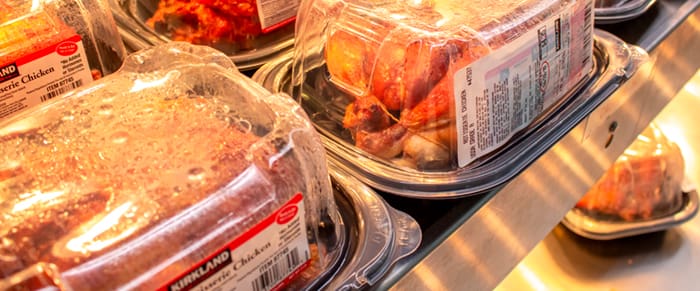
In our operations, unsold rotisserie chickens are made into deli entrees. Examples include:
- Chicken Noodle Soup, Chicken Enchilada Bake, Chicken Alfredo and Chicken Pot Pies sold in the U.S.
- Red Alfredo Chicken Penne and Honey Glazed Chicken Legs sold in Japan
- BBQ Chicken Wings, Chicken Enchiladas and Chicken & Mushroom Lattice Pies sold in the UK
- Singapore Laksa sold in Taiwan
Our delis continuously work to improve their procedures to reduce the amount of unsold chickens through improved efficiencies. In the U.S. from FY20 to FY21, our deli department decreased unsold chickens – reducing 68,332 pounds of excess rotisserie chickens.
Other source reduction initiatives include:
- Converting croissants into an Almond Croissant dessert item sold in Japan
- Sourcing ground beef from our own meat department to produce stuffed peppers and meatloaf in our deli – saving approximately 7.99 million pounds of wasted food in the U.S. in FY21
- Sourcing ground beef from Canada’s meat department to create Shepherd’s Pie and Stuffed Bell Peppers similar to the U.S.
- Introducing a high-quality smoothie to sell in Japan’s food courts in FY21, utilizing 39,683 pounds of unsold oranges from the sales floor

Feed Hungry People
Costco locations worldwide donate edible food to food banks and other nonprofits in their local communities. Donation programs vary by location and country. During FY21, many food banks were affected by COVID-19. Due to shortages in volunteers, donation pickups were negatively impacted making it difficult in some cases to get food donations to their destination. The global pandemic also created an overall increase in need from communities all over the world. Our goal was to continue to donate as much as possible to all communities to support those in need.
Food Donations
Costco continues to expand its program and partnership with Feeding America, The Global FoodBanking Network and other local food banks to prevent food from being wasted. Feeding America is a national organization in the U.S. that works with local food banks as a bridge with our U.S. locations. The Global FoodBanking Network partners non-U.S. locations with certified member organizations in order to confidently donate to entities that have established food safety standards throughout the food chain. Through these combined efforts, we are able to provide meals to individuals and families that are food insecure.
In FY21, Costco warehouses and depots donated more than 99 million pounds of edible food products in all states and most countries/regions where we operate, which represents over 82 million meals donated to people in need. We have continued to grow our program year over year. This year, the U.S. and Mexico added the ability to donate cooked food from our food courts by creating food safety procedures to properly cool and donate unsold items.
|
Costco understands the importance of the types of food donated. We strive to provide healthy and nutritious food. In FY21, 72% of the food donated in the U.S. was in the following categories: Produce/fruit/vegetables (39.4%), Grains/bread (21.3%) and Dairy/protein (11.2%).
Feed Animals
Feeding animals our inedible waste is important because it reduces the demand to generate new feed resources. Additionally, our warehouses divert organic materials by supporting local donation programs, including animal sanctuaries, rescue centers, local farms and city zoos. Examples during FY21 include:
- 179 U.S. Costco warehouses sent 13.7 million pounds of organic materials to feed cattle and hogs.
- In Taiwan, 14 warehouses sent 8.82 million pounds of organic materials to pig farms.
- In Korea, 7.28 million pounds of organic material was sent to farms to feed animals.
- Our Kanazawa warehouse in Japan sent 1,118 pounds of coffee grounds to be repurposed as cattle feed. The coffee grounds contain antioxidants to keep the cows healthy and improve the quality of milk.
Industrial Uses
Much of our organic waste is now recycled into usable products, such as organic fertilizer, biofuels and electricity. Globally in FY21, Costco diverted over 419 million pounds of material from landfills. Examples include:
- 10.19 million pounds of chicken grease produced from rotisserie chickens were recycled, the majority of which was converted into biofuel in the U.S., Canada, Mexico, Japan, Australia, Spain and China.
- 301 million pounds of meat and bone scraps were processed through the rendering program in the U.S., Canada, Mexico, Japan, Australia, Spain and China. Rendering from the chicken complex has been added to this year's report accounting for the large increase in rendering pounds.
- 205,708 pounds of organic waste was converted into certified organic liquid fertilizer in the U.S.
- 25.36 million pounds of food were recycled at anaerobic digestion facilities to create energy in the U.S., the UK and France. The UK is actively adding food waste programs in their warehouses.
Composting
In the U.S., Canada, Korea, Iceland and China, some locations send organic waste to commercial compost facilities to create a nutrient-rich soil conditioner. Warehouses have sent 33.97 million pounds to compost facilities during FY21.
Waste to Energy (WTE)/Landfill
Our compactors are hauled to waste-to-energy facilities and landfills. Our goal is to continuously move food waste out of compactors to more beneficial uses in the food waste hierarchy, while being compliant with regulations.
REDUCING NON-FOOD WASTE
Costco continues to find ways to reduce non-food waste through efficiencies and other methods, some of which are described below.
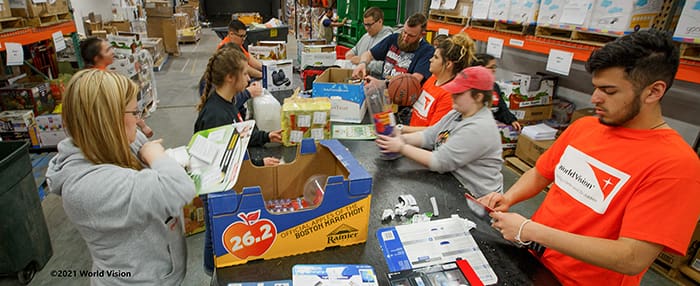
Donate
Costco has grown its program with World Vision to donate first-quality items that used to be destroyed, recycled or returned to the supplier. In FY21, we donated to people in need in 32 countries.
More information can be found in the Costco-World Vision Summary, which contains a list of the items donated and some stories that illustrate the impact of these donations.
|
Besides providing items to people in need valued at over $137 million for FY21, efficiencies are also gained, including reduced trips to the landfill and savings on trash fees for both Costco and our suppliers. The increase in this year's donations is primarily related to additional donations from Costco Logistics.
Recycle

Corrugated Cardboard and Shrink-wrap
Warehouses routinely backhaul shrink-wrap and corrugated material generated from daily operations to our distribution centers in order to recycle. This practice, together with recycling at our newly acquired business, Costco Logistics, diverted over 680,186 tons of material from the landfill in FY21, while generating income and reducing our carbon footprint. This is an increase of 80,142 tons or 13.3% over last year.
Tires
Costco recycled over 6.3 million tires in the U.S. in FY21. While 15% of our tires are resold, over 80% are recycled into several different beneficial uses like tire-derived fuels used primarily in cement kilns; crumb rubber used as an additive for road surfaces or pervious surfaces around roads, sidewalks and pathways; mine reclamation; daily landfill cover; and decorative mulch. Globally, Costco diverted over 175 million pounds of tires.
Car Battery Recycling
Globally in FY21, Costco recycled 68.6 million pounds of auto batteries. Costco reimburses members their core fee when batteries are returned for recycling. Returned batteries are collected and picked up for recycling by Costco battery suppliers.
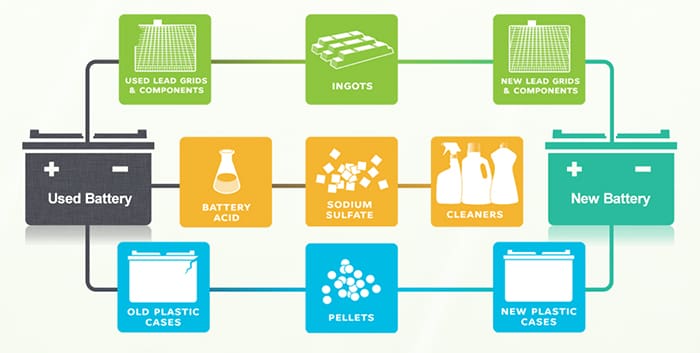
Up to 99% of a car battery is recyclable and can be used to make new batteries and other products.
Paper
Costco has established a recycling program for paper in our offices and warehouses to capture loose paper, coupon brochures, magazines, and paperback books that are no longer usable or saleable. In FY21, we recycled over 10.6 million pounds of paper in the U.S., Canada, Mexico, the UK, Japan, Taiwan, Australia and Spain. We continue to move to paperless programs when applicable.
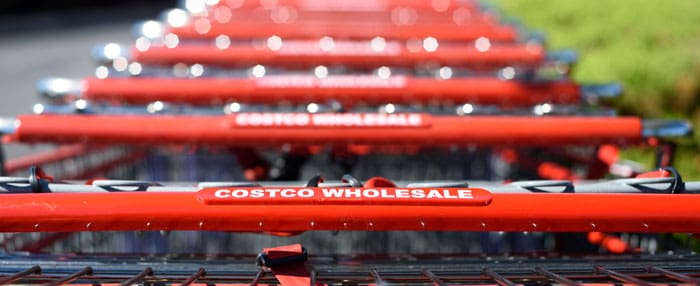
Metal
In FY20, Costco piloted a program with our depots to recycle scrap metal that cannot be processed through standard single stream recycling bins. During FY21, we have continued to expand this program. There are currently 485 U.S. warehouses participating in this program, an increase of 400 warehouses, and we will continue to roll out to new locations where feasible. Collectively, through our pilot program and other local scrap metal programs, Costco was able to recycle 11.1 million pounds of scrap metal in the U.S. An additional 1.3 million pounds of scrap metal was recycled in Canada, Mexico, the UK, Japan, Taiwan and Australia.
Recycle to Repurpose - Styrofoam®
In the U.S., Japan, Korea, Taiwan and China, Costco recycled 2.1 million pounds of expanded polystyrene (foam) in FY21. This material is densified and distributed to manufacturers that make picture frames, crown molding and other polystyrene products.
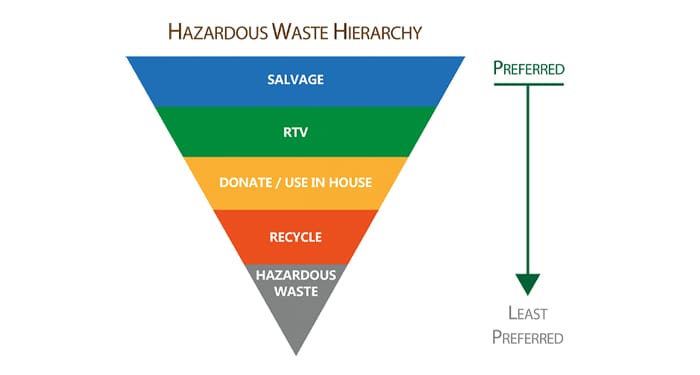
REDUCING HAZARDOUS WASTE
Hazardous materials are those products that pose a risk to the environment, human health, and/or the communities we operate. This includes common everyday items such as dish soaps, detergents, batteries, light bulbs and electronics. Costco’s continued commitment to sustainability and waste reduction has resulted in a number of programs that help us operate efficiently and in an environmentally responsible manner when managing products that cannot be donated or salvaged.
As with other waste programs, Costco follows a similar hierarchy to reduce or eliminate hazardous waste as we do with solid waste streams. Prevention is the most desired path when dealing with products, which are deemed hazardous.

Electronic Recycling
Costco maintains a robust electronic recycling program through approved, licensed recycling vendors. Costco is able to manage both member returns and company assets while ensuring the highest levels of sensitive data destruction alongside material recovery through the vendor’s e-scrap shredding system. In FY21, we recycled 14.6 million pounds of electronic waste in the U.S., Canada, Mexico, the UK, Japan, Taiwan, Australia, Spain and France.

Batteries & Light Bulbs
Household batteries and light bulbs are two of the most common items to be recycled in each location. Each battery and bulb is broken down to its rawest parts and recycled or repurposed accordingly.
Costco recycles household batteries and light bulbs that are either returned by members or used internally in operations. In FY21, we recycled 233,477 pounds of batteries and light bulbs in the U.S., Canada, Mexico, the UK, Japan, Taiwan, Spain, France and China.

Fuel Station Materials
Byproducts from our fuel station operations are managed in a variety of ways aimed at waste minimization. Used and drained fuel filters can be managed as scrap material. In FY21, we recycled 54,170 pounds of fuel filters.
Ethanol Recovery
Items containing ethanol such as: alcoholic spirits, perfumes, colognes, cough syrup, vanilla extract and hand sanitizers are hauled off-site, depacked and shredded at downstream facilities. The liquids are collected from the shredding process and batched for ethanol recovery. Various methods are used to separate and collect ethanol for final reuse as additives to new products or liquid fuels. In FY21, we repurposed 38,635 pounds of material.